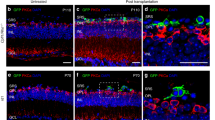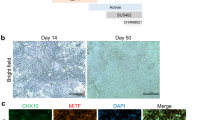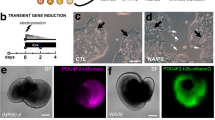Abstract
Photoreceptor loss causes irreversible blindness in many retinal diseases. Repair of such damage by cell transplantation is one of the most feasible types of central nervous system repair; photoreceptor degeneration initially leaves the inner retinal circuitry intact and new photoreceptors need only make single, short synaptic connections to contribute to the retinotopic map. So far, brain- and retina-derived stem cells transplanted into adult retina have shown little evidence of being able to integrate into the outer nuclear layer and differentiate into new photoreceptors1,2,3,4. Furthermore, there has been no demonstration that transplanted cells form functional synaptic connections with other neurons in the recipient retina or restore visual function. This might be because the mature mammalian retina lacks the ability to accept and incorporate stem cells or to promote photoreceptor differentiation. We hypothesized that committed progenitor or precursor cells at later ontogenetic stages might have a higher probability of success upon transplantation. Here we show that donor cells can integrate into the adult or degenerating retina if they are taken from the developing retina at a time coincident with the peak of rod genesis5. These transplanted cells integrate, differentiate into rod photoreceptors, form synaptic connections and improve visual function. Furthermore, we use genetically tagged post-mitotic rod precursors expressing the transcription factor Nrl (ref. 6) (neural retina leucine zipper) to show that successfully integrated rod photoreceptors are derived only from immature post-mitotic rod precursors and not from proliferating progenitor or stem cells. These findings define the ontogenetic stage of donor cells for successful rod photoreceptor transplantation.
This is a preview of subscription content, access via your institution
Access options
Subscribe to this journal
Receive 51 print issues and online access
$199.00 per year
only $3.90 per issue
Buy this article
- Purchase on Springer Link
- Instant access to full article PDF
Prices may be subject to local taxes which are calculated during checkout




Similar content being viewed by others
References
Chacko, D. M., Rogers, J. A., Turner, J. E. & Ahmad, I. Survival and differentiation of cultured retinal progenitors transplanted in the subretinal space of the rat. Biochem. Biophys. Res. Commun. 268, 842–846 (2000)
Sakaguchi, D. S. et al. Transplantation of neural progenitor cells into the developing retina of the Brazilian opossum: an in vivo system for studying stem/progenitor cell plasticity. Dev. Neurosci. 26, 336–345 (2004)
Van Hoffelen, S. J., Young, M. J., Shatos, M. A. & Sakaguchi, D. S. Incorporation of murine brain progenitor cells into the developing mammalian retina. Invest. Ophthalmol. Vis. Sci. 44, 426–434 (2003)
Young, M. J., Ray, J., Whiteley, S. J., Klassen, H. & Gage, F. H. Neuronal differentiation and morphological integration of hippocampal progenitor cells transplanted to the retina of immature and mature dystrophic rats. Mol. Cell. Neurosci. 16, 197–205 (2000)
Young, R. W. Cell differentiation in the retina of the mouse. Anat. Rec. 212, 199–205 (1985)
Akimoto, M. et al. Targeting of green fluorescent protein to new-born rods by Nrl promoter and temporal expression profiling of flow-sorted photoreceptors. Proc. Natl Acad. Sci. USA 103, 3890–3895 (2006)
Okabe, M., Ikawa, M., Kominami, K., Nakanishi, T. & Nishimune, Y. 'Green mice' as a source of ubiquitous green cells. FEBS Lett. 407, 313–319 (1997)
Yang, P., Seiler, M. J., Aramant, R. B. & Whittemore, S. R. Differential lineage restriction of rat retinal progenitor cells in vitro and in vivo. J. Neurosci. Res. 69, 466–476 (2002)
Carter-Dawson, L. D. & LaVail, M. M. Rods and cones in the mouse retina. II. Autoradiographic analysis of cell generation using tritiated thymidine. J. Comp. Neurol. 188, 263–272 (1979)
Terada, N. et al. Bone marrow cells adopt the phenotype of other cells by spontaneous cell fusion. Nature 416, 542–545 (2002)
Ying, Q. L., Nichols, J., Evans, E. P. & Smith, A. G. Changing potency by spontaneous fusion. Nature 416, 545–548 (2002)
Weimann, J. M., Johansson, C. B., Trejo, A. & Blau, H. M. Stable reprogrammed heterokaryons form spontaneously in Purkinje neurons after bone marrow transplant. Nature Cell Biol. 5, 959–966 (2003)
Hadjantonakis, A. K., Macmaster, S. & Nagy, A. Embryonic stem cells and mice expressing different GFP variants for multiple non-invasive reporter usage within a single animal. BMC Biotechnol. 2, 11 (2002)
Kashofer, K. & Bonnet, D. Gene therapy progress and prospects: stem cell plasticity. Gene Ther. 12, 1229–1234 (2005)
Swaroop, A. et al. A conserved retina specific gene encodes a basic motif/leucine zipper domain. Proc. Natl Acad. Sci. USA 89, 266–270 (1992)
Mears, A. J. et al. Nrl is required for rod photoreceptor development. Nature Genet. 29, 447–452 (2001)
Swain, P. K. et al. Multiple phosphorylated isoforms of NRL are expressed in rod photoreceptors. J. Biol. Chem. 276, 36824–36830 (2001)
tom Dieck, S. et al. Molecular dissection of the photoreceptor ribbon synapse: physical interaction of Bassoon and RIBEYE is essential for the assembly of the ribbon complex. J. Cell Biol. 168, 825–836 (2005)
Koulen, P., Kuhn, R., Wassle, H. & Brandstatter, J. H. Modulation of the intracellular calcium concentration in photoreceptor terminals by a presynaptic metabotropic glutamate receptor. Proc. Natl Acad. Sci. USA 96, 9909–9914 (1999)
Koulen, P. & Brandstatter, J. H. Pre- and postsynaptic sites of action of mGluR8a in the mammalian retina. Invest. Ophthalmol. Vis. Sci. 43, 1933–1940 (2002)
Wells, J. et al. Mutations in the human retinal degeneration slow (RDS) gene can cause either retinitis pigmentosa or macular dystrophy. Nature Genet. 3, 213–218 (1993)
McLaughlin, M. E., Sandberg, M. A., Berson, E. L. & Dryja, T. P. Recessive mutations in the gene encoding the beta-subunit of rod phosphodiesterase in patients with retinitis pigmentosa. Nature Genet. 4, 130–134 (1993)
Rosenfeld, P. J. et al. A null mutation in the rhodopsin gene causes rod photoreceptor dysfunction and autosomal recessive retinitis pigmentosa. Nature Genet. 1, 209–213 (1992)
Reuter, J. H. & Sanyal, S. Development and degeneration of retina in rds mutant mice: the electroretinogram. Neurosci. Lett. 48, 231–237 (1984)
Sanyal, S., Hawkins, R. K. & Zeilmaker, G. H. Development and degeneration of retina in rds mutant mice: analysis of interphotoreceptor matrix staining in chimaeric retina. Curr. Eye Res. 7, 1183–1190 (1988)
Carter-Dawson, L. D., LaVail, M. M. & Sidman, R. L. Differential effect of the rd mutation on rods and cones in the mouse retina. Invest. Ophthalmol. Vis. Sci. 17, 489–498 (1978)
Humphries, M. M. et al. Retinopathy induced in mice by targeted disruption of the rhodopsin gene. Nature Genet. 15, 216–219 (1997)
Toda, K., Bush, R. A., Humphries, P. & Sieving, P. A. The electroretinogram of the rhodopsin knockout mouse. Vis. Neurosci. 16, 391–398 (1999)
Lucas, R. J., Douglas, R. H. & Foster, R. G. Characterization of an ocular photopigment capable of driving pupillary constriction in mice. Nature Neurosci. 4, 621–626 (2001)
Acknowledgements
We thank Y. Duran and N. Gent for technical assistance, P. Humphries for providing the rhodopsin knockout mouse, R. Molday and G. Travis for providing antibodies, and J. Partridge for light calibrations. This work was supported by grants from the Medical Research Council UK, the Royal Blind Asylum and School and The Scottish National Institute for the War Blinded. Development of the Nrl-gfp+/+ transgenic line was supported by grants from the National Institutes of Health, The Foundation Fighting Blindness and Research to Prevent Blindness.
Author information
Authors and Affiliations
Corresponding author
Ethics declarations
Competing interests
Reprints and permissions information is available at www.nature.com/reprints. The authors declare no competing financial interests.
Supplementary information
Supplementary Methods
This file contains additional details of the methods used in this study. (DOC 56 kb)
Supplementary Figure Legends
Text to accompany the below Supplementary Figures. (DOC 25 kb)
Supplementary Figure 1
Schematic summary of findings (JPG 117 kb)
Supplementary Figure 2
Transplantation occurs via integration not cell fusion. (JPG 42 kb)
Supplementary Figure 3
E11.5 cells express markers of progenitor cells. (JPG 49 kb)
Supplementary Figure 4
E11.5 cells survive and are able to differentiate in the subretinal space of adult host retinas. (JPG 87 kb)
Supplementary Figure 5
Transplantation into the rd mouse. (JPG 34 kb)
Rights and permissions
About this article
Cite this article
MacLaren, R., Pearson, R., MacNeil, A. et al. Retinal repair by transplantation of photoreceptor precursors. Nature 444, 203–207 (2006). https://doi.org/10.1038/nature05161
Received:
Accepted:
Issue Date:
DOI: https://doi.org/10.1038/nature05161
This article is cited by
-
Transplanted human photoreceptors transfer cytoplasmic material but not to the recipient mouse retina
Stem Cell Research & Therapy (2024)
-
New Perspectives in Stem Cell Transplantation and Associated Therapies to Treat Retinal Diseases: From Gene Editing to 3D Bioprinting
Stem Cell Reviews and Reports (2024)
-
Soluble CX3CL1-expressing retinal pigment epithelium cells protect rod photoreceptors in a mouse model of retinitis pigmentosa
Stem Cell Research & Therapy (2023)
-
Increasing cell culture density during a developmental window prevents fated rod precursors derailment toward hybrid rod-glia cells
Scientific Reports (2023)
-
Stages, pathogenesis, clinical management and advancements in therapies of age-related macular degeneration
International Ophthalmology (2023)
Comments
By submitting a comment you agree to abide by our Terms and Community Guidelines. If you find something abusive or that does not comply with our terms or guidelines please flag it as inappropriate.



